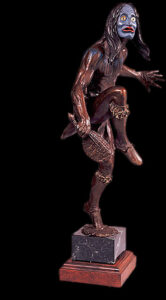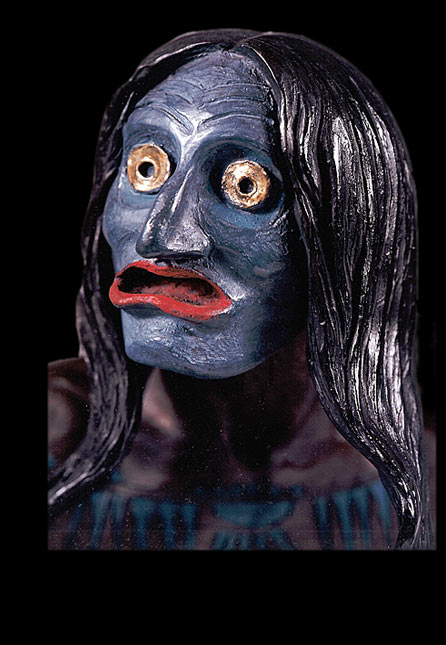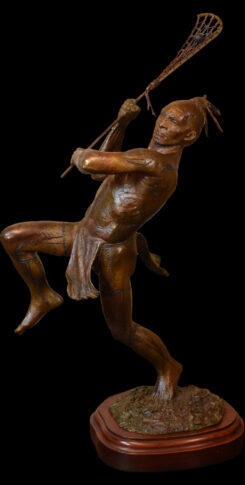Bronze edition: 20 | Height: 22″
An Iroquois Shaman of the False Face Society performing a curing ritual.
Shamans were those who claimed to control supernatural powers; who obtained special potency thru visions and dreams in which powerful spirits revealed themselves to those whose orenda (a potentiality to do or effect results mystically) were great.
The prominence of masks among Iroquois rituals and supernatural beliefs implies their great importance. Indeed, among the Iroquois, nothing was more sacred than the Faces. False – Faced dancers performed dramatic pantomime at New Years and green corn ceremonies; they drove out witches and disease in the spring and the fall and they cured illness at any time of the year. When Medicine Society members wear False Faces in curing rituals and religious ceremonies, they portray supernatural spirits who inhabit the forest and thus become endowed with their orenda. Accoutrements include large mud turtle rattles as well as a type of rattle worn as a leg garter made from deer dew-claws.
Sacred tobacco was burned as an offering to a living basswood tree before the first carving was done. Only sincere men could “ask the life” and carve masks that would contain the life spirit of the tree. Once the carving was nearly complete, the trunk was notched above and below so that it could be split away. The masks were completed with care: its back hollowed out to receive the wearers face and finally “baptized” by being placed briefly in the fire at the council – house meeting. Here the great False – Face of whom the mask was a representation, was supplicated with sacred tobacco thrown onto the burning embers. Once thus “baptized”, a mask was alive and charged with a power that could do almost limitless good or ill. On old masks buffalo hair was often used, horse hair on more recent masks. The eyes were usually made of polished metal discs (these would reflect firelight at night), with bright pigments painted on the wood and then carefully oiled.
European culture with its tolerance of external restraints produced individuals whose chief problem was guilt, especially over wishes for aggressive, dominant independence. European religion provided a variety of rituals for the management of guilt: confession, absolution, forgiveness, etc. Iroquois religious practice, on the other hand, did not pay much attention to guilt because they were not much bothered by it.
In general, Iroquois religion tended to compensate for the sacrifices entailed in living up to the ideal of autonomous responsibility with its stoical endurance of loneliness, discomfort and physical hardship and pain. Iroquois rituals, including False – Face Society ceremonies, worked to provide reassurance of continued protection and support from supernaturals and ultimate impulse gratification, especially of desires for nurturance and dependency that could not be expressed in daily life. In disguised, ceremonial and symbolic form, these rituals prevented both mental illness and social disorder.






